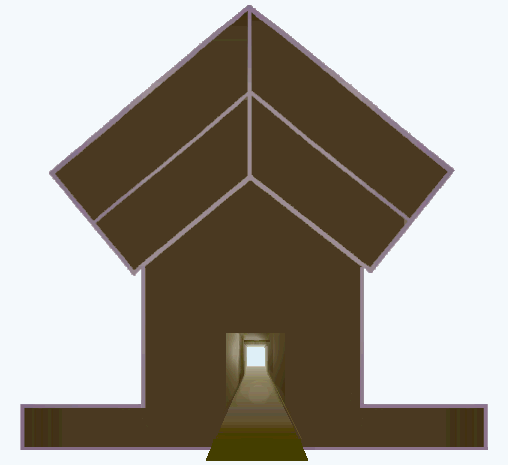Path through the Pyramid
Part 6

The unfinished Pyramid
Exit from the Pyramid starts from the bottom of the Descending Passage, returning us through the entrance portal to Egypt's daylight.
Outside the Pyramid the absence of the capstone comes to notice: a dissonance that is out of harmony with the rest of the exterior.1 It was not the only example of unfinished work. A surprising absence of finish was observed in all three chambers—the more surprising in that the chambers do not seem to have merited the same level of finish as the magnificently dressed facing stones of the Pyramid's exterior. Instead, the floor of each chamber appears to be part of a gradational pattern of incompletion, from the least finished floor of the bottom chamber to the nearly finished uppermost.
Did time simply run out for the Pyramid masons? After completing so much of their huge project, the omissions beg explanation.
Return to the present
Reflections on the enigma and origins of the Great Pyramid
I am the primeval hill of the land in the midst of the sea, whose hand no earthlings have grasped, and no earthlings have grasped my hand.
(Utterance 484. The Ancient Pyramid Texts)
Egypt's pyramids are believed to date back to the 3rd and 4th dynasties of the Old Kingdom (c.2700-2500 BCE). Neither the first nor last of the pyramids built, the Great Pyramid stands on the Giza plateau as the pinnacle of Egyptian building achievement. The generally accepted view holds that it was built during the reign of the pharaoh, Khufu, whose cartouche was found above the King's Chamber.
There must have been a point in human history when an idea took hold of Egyptian consciousness to become the compelling motive for a building programme. Conventional wisdom ascribes a funerary function to the pyramids (tombs constructed for Egypt's early pharaohs), but lacking inscription or evidence of burial the purpose behind the series of huge building projects remains uncertain. The question is asked if there could be more to the onset of pyramid building than a mausoleum personal to the reigning pharaoh. What was the narrative that lay behind the whole building project? What is known, or can be deduced about designer intentions?
A possible clue to the origins of pyramid construction may be found in ancient writings in which a primeval hill is described that was before all existence came into being. Impossible to miss the resemblance to a pyramid during periods of annual inundation, or connection to ancient Egyptian concepts about the origins of the cosmos, namely the beginning of Time and physical matter. Both aspects of Creation find a place in the King's Chamber through numerous 36524 sightings alluding to the Earth-year, pointing to a chamber and tomb intended for the Lord of the Year. (Part 5)
Genesis texts
What does Genesis tell us about the Pyramid? A whole new level of data is offered through numerical signifiers for Hebrew names and gematria supporting a creation plan with messianic elements similar to the cult of Osiris. The burden of the Genesis texts shows the Pyramid as a monument to fruitfulness and 'set times’, to goodness and one-ness, a memorial to a god-man.
From the Pyramid chambers come intimations of purpose: the unfinished subterranean chamber with its dioramic resemblance to the imagery of Genesis 1:2; the middle chamber with three name-signifiers and the coming of the Light; the uppermost King's Chamber with its complement of eight name-signifiers, and the open coffer and masonry featuring a radical change from limestone to more durable granite. Beyond these clues a waiting aura is conveyed by the Pyramid's unfinished state and Hebrew verbs: the latter at variance with a tomb for a long-dead pharaoh, but in keeping with a shrine to Creation and the coming and return of an expected one.
Concluding remarks
Since the passing of the ancient civilization, much speculation has centred on the Great Pyramid's unique features, purpose and method of construction. Modern pyramidology began with John Taylor in 1859. The Great Pyramid's mathematical association with pi, first suspected by him, was taken up by Piazzi Smyth who was quickly followed by a new generation of pyramidologists perceiving the Pyramid as a prophetic structure with biblical connections. Jack Edwards saw the Promised One of Israel in the measurements of the Pyramid passage system and the standard numbers that underscore the Genesis text and later prophets.2 The numbers, which are names for God, are defined in his book Gematria. The website is a voyage of discovery in support of his findings.3
In setting out to trace the principal pathways of the One, the overarching concern has been to allow the gematria to speak for itself in the main body of work, leaving texts to the judgement and conclusions of the reader. Much depends on verification of the evidence. It is hoped the findings will prompt investigation and further discoveries into this association between the Great Pyramid and Genesis; the bearing it may have on the age of pyramid building and its message for our own time.
Information supplied in the website is drawn mainly from the following sources: the investigations, ideas and methods of Jack Edwards; occurrence data for Genesis texts;4 the texts, which are drawn from the translation into English by Dr S.P. Tregelles; and the great debt owed to Adam Rutherford for his figures for the Pyramid's internal dimensions based on his geometrical reconstruction of the original design.5
J M Edwards
includingconsometactredundant@textpatheveryamid.intervalcom
excludingenqumanyirieuselesss@characterspatheveryotheramid.periodcom
Footnotes
1
Absence of the capstone raises questions about the builders' intentions
and may be the occasion of some pointed observations by biblical writers on an
intentional omission.
(Psalm 118:22-23, Isaiah 28:16)
2
Jeremiah verse
Table 4
3
Rutherford & Edwards
Note 2: Pyramid base. Measures and theories
4
Ref. Occurrence Data for Genesis
GenData. See book details
5
Ref. Adam Rutherford's Pyramidology in 4 volumes
Bibliography